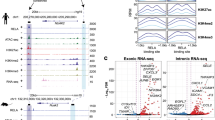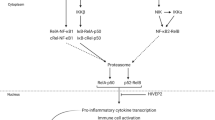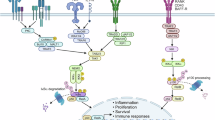Abstract
The immunologic signals participating in immune responses early in life have not been completely elucidated. Regarding the characterization of neonatal cells, little is known concerning the activity of transcription factor nuclear factor kappa B (NF-κB), which regulates inflammatory genes and cytokine production. The aim of this study was to characterize NF-κB activation in cord blood mononuclear cells (CBMC). We analyzed the potential association of NF-κB activity with lymphocyte proliferation and influences on cytokine secretion in the early immune system. To determine the contribution of a disease whereby inheritance may impact neonatal immunity, we assessed the influence of maternal allergic disease on NF-κB regulation and cytokine secretion. CBMC from healthy newborns were isolated and stimulated with mitogen (n = 28). Nuclear extracts were analyzed by electrophoretic mobility shift assay, cytokine secretion by ELISA. FISH analysis excluded relevant maternal contamination of CBMC. All samples showed a positive lymphoproliferative response, and NF-κB activity was both increased and decreased after mitogen stimulation. Increased NF-κB activation was significantly associated with decreased TNF-α secretion (median 6.1 versus 50.3 pg/mL) in unstimulated CBMC. Mitogen stimulation resulted in increased NF-κB activity with a trend to increased IL-13 production. Maternal allergic disease was associated with higher TNF-α (median 982 versus 173 pg/mL) and IL-13 secretion (median 1328 versus 1120 pg/mL) after mitogen stimulation. Together, NF-κB activity is differentially activated in cord blood and associated with a distinct cytokine pattern. Whether differential NF-κB activity in cord blood is related to the subsequent development of immune diseases requires further investigation.
Similar content being viewed by others
Log in or create a free account to read this content
Gain free access to this article, as well as selected content from this journal and more on nature.com
or
Abbreviations
- CBMC:
-
cord blood mononuclear cells
- EMSA:
-
electrophoretic mobility shift assay
- IFN-γ:
-
interferon gamma
- NF-κB:
-
nuclear factor kappa B
- PHA:
-
phytohemagglutinin
- SI:
-
stimulation index
- Th:
-
T helper
- TNF-α:
-
tumor necrosis factor alpha
References
Marquardt DL, Walker LL 2000 Dependence of mast cell IgE-mediated cytokine production on nuclear factor-kappaB activity. J Allergy Clin Immunol 105: 500–505.
Schmedtje JF Jr, Ji YS, Liu WL, DuBois RN, Runge MS 1997 Hypoxia induces cyclooxygenase-2 via the NF-kappaB p65 transcription factor in human vascular endothelial cells. J Biol Chem 272: 601–608.
Chu SC, Marks-Konczalik J, Wu HP, Banks TC, Moss J 1998 Analysis of the cytokine-stimulated human inducible nitric oxide synthase (iNOS) gene: characterization of differences between human and mouse iNOS promoters. Biochem Biophys Res Commun 248: 871–878.
Escoubet-Lozach L, Glass CK, Wasserman SI 2002 The role of transcription factors in allergic inflammation. J Allergy Clin Immunol 110: 553–564.
Christman JW, Sadikot RT, Blackwell TS 2000 The role of nuclear factor-kappa B in pulmonary diseases. Chest 117: 1482–1487.
Barnes PJ, Karin M 1997 Nuclear factor-kappaB: a pivotal transcription factor in chronic inflammatory diseases. N Engl J Med 336: 1066–1071.
Christman JW, Lancaster LH, Blackwell TS 1998 Nuclear factor kappa B: a pivotal role in the systemic inflammatory response syndrome and new target for therapy. Intensive Care Med 24: 1131–1138.
Bureau F, Delhalle S, Bonizzi G, Fievez L, Dogne S, Kirschvink N, Vanderplasschen A, Merville MP, Bours V, Lekeux P 2000 Mechanisms of persistent NF-kappaB activity in the bronchi of an animal model of asthma. J Immunol 165: 5822–5830.
Baeuerle PA, Baltimore D 1996 NF-kappa B: ten years after. Cell 87: 13–20.
Baldwin AS Jr 2001 Series introduction: the transcription factor NF-kappaB and human disease. J Clin Invest 107: 3–6.
Siebenlist U, Franzoso G, Brown K 1994 Structure, regulation and function of NF-kappa B. Annu Rev Cell Biol 10: 405–455.
Prescott SL 2001 The significance of immune responses to allergens in early life. Clin Exp Allergy 31: 1167–1169.
Prescott SL, Macaubas C, Holt BJ, Smallacombe TB, Loh R, Sly PD, Holt PG 1998 Transplacental priming of the human immune system to environmental allergens: universal skewing of initial T cell responses toward the Th2 cytokine profile. J Immunol 160: 4730–4737.
Macaubas C, Holt PG 2001 Regulation of cytokine production in T-cell responses to inhalant allergen: GATA-3 expression distinguishes between Th1- and Th2-polarized immunity. Int Arch Allergy Immunol 124: 176–179.
Das J, Chen CH, Yang L, Cohn L, Ray P, Ray A 2001 A critical role for NF-kappa B in GATA3 expression and TH2 differentiation in allergic airway inflammation. Nat Immunol 2: 45–50.
Warner JA, Miles EA, Jones AC, Quint DJ, Colwell BM, Warner JO 1994 Is deficiency of interferon gamma production by allergen triggered cord blood cells a predictor of atopic eczema? Clin Exp A. llergy 24: 423–430.
Rinas U, Horneff G, Wahn V 1993 Interferon-gamma production by cord-blood mononuclear cells is reduced in newborns with a family history of atopic disease and is independent from cord blood IgE-levels. Pediatr Allergy Immunol 4: 60–64.
Liao SY, Liao TN, Chiang BL, Huang MS, Chen CC, Chou CC, Hsieh KH 1996 Decreased production of IFN gamma and increased production of IL-6 by cord blood mononuclear cells of newborns with a high risk of allergy. Clin Exp Allergy 26: 397–405.
Jones AC, Miles EA, Warner JO, Colwell BM, Bryant TN, Warner JA 1996 Fetal peripheral blood mononuclear cell proliferative responses to mitogenic and allergenic stimuli during gestation. Pediatr Allergy Immunol 7: 109–116.
Szepfalusi Z, Nentwich I, Gerstmayr M, Jost E, Todoran L, Gratzl R, Herkner K, Urbanek R 1997 Prenatal allergen contact with milk proteins. Clin Exp Allergy 27: 28–35.
Chan-Yeung M, Ferguson A, Chan H, Dimich-Ward H, Watson W, Manfreda J, Becker A 1999 Umbilical cord blood mononuclear cell proliferative response to house dust mite does not predict the development of allergic rhinitis and asthma. J Allergy Clin Immunol 104: 317–321.
Smillie FI, Elderfield AJ, Patel F, Cain G, Tavenier G, Brutsche M, Craven M, Custovic A, Woodcock A 2001 Lymphoproliferative responses in cord blood and at one year: no evidence for the effect of in utero exposure to dust mite allergens. Clin Exp Allergy 31: 1194–1204.
Miller RL, Chew GL, Bell CA, Biedermann SA, Aggarwal M, Kinney PL, Tsai WY, Whyatt RM, Perera FP, Ford JG 2001 Prenatal exposure, maternal sensitization, and sensitization in utero to indoor allergens in an inner-city cohort. Am J Respir Crit Care Med 164: 995–1001.
Prescott SL, Holt PG 1998 Abnormalities in cord blood mononuclear cytokine production as a predictor of later atopic disease in childhood. Clin Exp Allergy 28: 1313–1316.
Schreiber E, Matthias P, Muller MM, Schaffner W 1989 Rapid detection of octamer binding proteins with ‘mini-extracts’, prepared from a small number of cells. Nucleic Acids Res 17: 6419
Donovan CE, Mark DA, He HZ, Liou HC, Kobzik L, Wang Y, De Sanctis GT, Perkins DL, Finn PW 1999 NF-kappa B/Rel transcription factors: c-Rel promotes airway hyperresponsiveness and allergic pulmonary inflammation. J Immunol 163: 6827–6833.
Finn PW, Stone JR, Boothby MR, Perkins DL 2001 Inhibition of NF-kappaB-dependent T cell activation abrogates acute allograft rejection. J Immunol 167: 5994–6001.
Clerici M, DePalma L, Roilides E, Baker R, Shearer GM 1993 Analysis of T helper and antigen-presenting cell functions in cord blood and peripheral blood leukocytes from healthy children of different ages. J Clin Invest 91: 2829–2836.
Szepfalusi Z, Pichler J, Elsasser S, van Duren K, Ebner C, Bernaschek G, Urbanek R 2000 Transplacental priming of the human immune system with environmental allergens can occur early in gestation. J Allergy Clin Immunol 106: 530–536.
Holt PG, O'Keeffe P, Holt BJ, Upham JW, Baron-Hay MJ, Suphioglu C, Knox B, Stewart GA, Thomas WR, Sly PD 1995 T-cell “priming” against environmental allergens in human neonates: sequential deletion of food antigen reactivity during infancy with concomitant expansion of responses to ubiquitous inhalant allergens. Pediatr Allergy Immunol 6: 85–90.
Hart LA, Krishnan VL, Adcock IM, Barnes PJ, Chung KF 1998 Activation and localization of transcription factor, nuclear factor-kappaB, in asthma. Am J Respir Crit Care Med 158: 1585–1592.
Jarvis JN, Zhao L, Xu CS, Moore HT, Berry S 1997 Constitutive expression c-fos, c-jun, and NF kappa B mRNA is in nucleated fetal blood cells and up-regulation of c-fos and c-jun with anti-CD3 stimulation. Biol Neonate 72: 329–336.
Vancurova I, Bellani P, Davidson D 2001 Activation of nuclear factor-kappaB and its suppression by dexamethasone in polymorphonuclear leukocytes: newborn versus adult. Pediatr Res 49: 257–262.
Kilpinen S, Henttinen T, Lahdenpohja N, Hulkkonen J, Hurme M 1996 Signals leading to the activation of NF-kappa B transcription factor are stronger in neonatal than adult T lymphocytes. Scand J Immunol 44: 85–88.
Vancurova I, Miskolci V, Davidson D 2001 NF-kappa B activation in tumor necrosis factor alpha-stimulated neutrophils is mediated by protein kinase Cdelta. Correlation to nuclear Ikappa Balpha. J Biol Chem 276: 19746–19752.
Akira S, Kishimoto T 1997 NF-IL6 and NF-kappa B in cytokine gene regulation. Adv Immunol 65: 1–46.
Baldwin AS Jr 1996 The NF-kappa B and I kappa B proteins: new discoveries and insights. Annu Rev Immunol 14: 649–683.
Muller CW, Rey FA, Harrison SC 1996 Comparison of two different DNA-binding modes of the NF-kappa B p50 homodimer. Nat Struct Biol 3: 224–227.
Picado C, Bioque G, Roca-Ferrer J, Pujols L, Mullol J, Benitez P, Bulbena O 2003 Nuclear factor-kB activity is down-regulated in nasal polyps from aspirin-sensitive asthmatics. Allergy 58: 122–126.
Aronica MA, Mora AL, Mitchell DB, Finn PW, Johnson JE, Sheller JR, Boothby MR 1999 Preferential role for NF-kappa B/Rel signaling in the type 1 but not type 2 T cell-dependent immune response in vivo. J Immunol 163: 5116–5124.
Lin C-C, Lin C-Y, Ma H-Y 2000 Pulmonary function changes and increased Th-2 cytokine expression and nuclear factor kB activation in the lung after sensitization and allergen challenge in brown Norway rats. Immunol Lett 73: 57–64.
Yang L, Cohn L, Zhang DH, Homer R, Ray A, Ray P 1998 Essential role of nuclear factor kappaB in the induction of eosinophilia in allergic airway inflammation. J Exp Med 188: 1739–1750.
Liu SF, Haddad EB, Adcock I, Salmon M, Koto H, Gilbey T, Barnes PJ, Chung KF 1997 Inducible nitric oxide synthase after sensitization and allergen challenge of Brown Norway rat lung. Br J Pharmacol 121: 1241–1246.
Stacey MA, Sun G, Vassalli G, Marini M, Bellini A, Mattoli S 1997 The allergen Der p1 induces NF-kappaB activation through interference with IkappaB alpha function in asthmatic bronchial epithelial cells. Biochem Biophys Res Commun 236: 522–526.
Di Stefano A, Caramori G, Oates T, Capelli A, Lusuardi M, Gnemmi I, Ioli F, Chung KF, Donner CF, Barnes PJ, Adcock IM 2002 Increased expression of nuclear factor-kappaB in bronchial biopsies from smokers and patients with COPD. Eur Respir J 20: 556–563.
Graziano FM, Cook EB, Stahl JL 1999 Cytokines, chemokines, RANTES, and eotaxin. Allergy Asthma Proc 20: 141–146.
Hoontrakoon R, Chu HW, Gardai SJ, Wenzel SE, McDonald P, Fadok VA, Henson PM, Bratton DL 2002 Interleukin-15 inhibits spontaneous apoptosis in human eosinophils via autocrine production of granulocyte macrophage-colony stimulating factor and nuclear factor-kappa B activation. Am J Respir Cell Mol Biol 26: 404–412.
Hidi R, Riches V, Al-Ali M, Cruikshank WW, Center DM, Holgate ST, Djukanovic R 2000 Role of B7-CD28/CTLA-4 costimulation and NF-kappa B in allergen-induced T cell chemotaxis by IL-16 and RANTES. J Immunol 164: 412–418.
Kawano T, Matsuse H, Kondo Y, Machida I, Saeki S, Tomari S, Mitsuta K, Obase Y, Fukushima C, Shimoda T, Kohno S 2003 Cysteinyl leukotrienes induce nuclear factor kappa b activation and RANTES production in a murine model of asthma. J Allergy Clin Immunol 112: 369–374.
Boffa DJ, Feng B, Sharma V, Dematteo R, Miller G, Suthanthiran M, Nunez R, Liou HC 2003 Selective loss of c-Rel compromises dendritic cell activation of T lymphocytes. Cell Immunol 222: 105–115.
Barton D, HogenEsch H, Weih F 2000 Mice lacking the transcription factor RelB develop T cell-dependent skin lesions similar to human atopic dermatitis. Eur J Immunol 30: 2323–2332.
Piccinni MP, Beloni L, Giannarini L, Livi C, Scarselli G, Romagnani S, Maggi E 1996 Abnormal production of T helper 2 cytokines interleukin-4 and interleukin-5 by T cells from newborns with atopic parents. Eur J Immunol 26: 2293–2298.
Contreras JP, Ly NP, Gold DR, He H, Wand M, Weiss ST, Perkins DL, Platts-Mills TA, Finn PW 2003 Allergen-induced cytokine production, atopic disease, IgE, and wheeze in children. J Allergy Clin Immunol 112: 1072–1077.
Acknowledgements
The authors thank the participants and staff of Project Viva, Diane Sredl for program assistance, and Craig Lilly, Fiona Gibbons, and Abdel Bellou for critical review of the manuscript.
Author information
Authors and Affiliations
Corresponding author
Additional information
Supported by grant 5R01AI045007–04, HD 34568, HL 64925, HL 68041, HL 61907, DFG 711/1–1.
Rights and permissions
About this article
Cite this article
Schroeter, C., Schaub, B., Gold, D. et al. Nuclear Factor Kappa B Activation in Human Cord Blood Mononuclear Cells. Pediatr Res 56, 212–218 (2004). https://doi.org/10.1203/01.PDR.0000132850.33375.D0
Received:
Accepted:
Issue date:
DOI: https://doi.org/10.1203/01.PDR.0000132850.33375.D0
This article is cited by
-
Neonatal immune responses to TLR2 stimulation: Influence of maternal atopy on Foxp3 and IL-10 expression
Respiratory Research (2006)
-
Fetal Cord Blood: Aspects of Heightened Immune Responses
Journal of Clinical Immunology (2005)



